Response of Soil Moisture to Single-Rainfall Events under Three Vegetation Types in the Gully Region of the Loess Plateau
Abstract
:1. Introduction
2. Materials and Methods
2.1. Study Area
2.2. Experimental Design
2.2.1. Soil Properties Investigation
2.2.2. Forest Stand Characteristics
2.2.3. Root Distribution Characteristics
2.2.4. Precipitation
2.2.5. Soil Water Content
2.3. Data Analysis
3. Results
3.1. Temporal Variations in the Characteristics of Soil Moisture
3.1.1. Light Rainfall
3.1.2. Moderate Rainfall
3.1.3. Heavy Rainfall
3.1.4. Rainstorms
3.2. Spatial Variation in the Characteristics of Soil Moisture
3.2.1. Spatial Variation and Recharge of Soil Moisture under Different Rainfall Intensities
3.2.2. Cumulative Infiltration and Rainfall
3.2.3. Relationships between Vegetation/Soil Parameters and Soil Moisture Variation
4. Discussion
4.1. Responses of Soil Moisture to Different Rainfall Intensities
4.2. Replenishment of Soil Moisture under Different Rainfall Intensities
5. Conclusions
Author Contributions
Funding
Acknowledgments
Conflicts of Interest
References
- Allen, C.D.; Macalady, A.K.; Chenchouni, H.; Bachelet, D.; Mcdowell, N.; Vennetier, M.; Kitzberger, T.; Rigling, A.; Breshears, D.D.; Hogg, E.H. A global overview of drought and heat-induced tree mortality reveals emerging climate change risks for forests. For. Ecol. Manag. 2010, 259, 660–684. [Google Scholar] [CrossRef]
- Chen, S.L.; Wen, Z.M.; Jiang, H.; Zhao, Q.J.; Zhang, X.Y.; Chen, Y. Temperature Vegetation Dryness Index Estimation of Soil Moisture under Different Tree Species. Sustainability 2015, 7, 11401–11417. [Google Scholar] [CrossRef] [Green Version]
- Boyer, J.S. Plant productivity and environment. Science 1982, 218, 443–448. [Google Scholar] [CrossRef] [PubMed]
- Topp, G.C.; Watt, M.; Hayhoe, H.N. Point specific measurement and monitoring of soil water content with an emphasis on TDR. Can. Soil Sci. 1996, 76, 307–316. [Google Scholar] [CrossRef] [Green Version]
- Vieira, S.R.; Grego, C.R.; Topp, G.C.; Reynolds, W.D. Spatial relationships between soil water content and hydraulic conductivity in a highly structured clay soils. Appl. Soil Phys. Environ. Anal. 2015, 35, 75–90. [Google Scholar]
- Klamerus-Iwan, A.; Błońska, E. Canopy storage capacity and wettability of leaves and needles: The effect of water temperature changes. J. Hydrol. 2018, 559, 534–540. [Google Scholar] [CrossRef]
- Cheng, X.; An, S.; Li, B.; Chen, J.; Lin, G.; Liu, Y.; Luo, Y.; Liu, S. Summer rain pulse size and rainwater uptake by three dominant desert plants in a desertified grassland ecosystem in northwestern China. Plant Ecol. 2006, 184, 1–12. [Google Scholar] [CrossRef]
- Wang, X.P.; Zhang, Y.F.; Hu, R.; Pan, Y.X.; Berndtsson, R. Canopy storage capacity of xerophytic shrubs in northwestern China. J. Hydrol. 2012, 454–455, 152–159. [Google Scholar] [CrossRef]
- Hata, K.; Kawakami, K.; Kachi, N. Increases in soil water content after the mortality of non-native trees in oceanic island forest ecosystems are due to reduced water loss during dry periods. Sci. Total Environ. 2016, 545–546, 372–380. [Google Scholar] [CrossRef] [PubMed]
- Yang, Y.; Fu, B. Soil water migration in the unsaturated zone of semiarid region in China from isotope evidence. Hydrol. Earth Syst. Sci. 2017, 21, 1757–1767. [Google Scholar] [CrossRef] [Green Version]
- Koppel, J.V.D.; Rietkerk, M.; Weissing, F.J. Catastrophic vegetation shifts and soil degradation in terrestrial grazing systems. Trends Ecol. Evol. 1997, 12, 352–356. [Google Scholar] [CrossRef] [Green Version]
- Van, D.K.J.; Rietkerk, M.; Van, L.F.; Kumar, L.; Klausmeier, C.A.; Fryxell, J.M.; Hearne, J.W.; Van, A.J.; De, R.N.; Skidmore, A. Spatial heterogeneity and irreversible vegetation change in semiarid grazing systems. Am. Nat. 2002, 159, 209–218. [Google Scholar]
- Van, D.K.J.; Rietkerk, M. Spatial interactions and resilience in arid ecosystems. Am. Nat. 2004, 163, 113–121. [Google Scholar]
- Rosenbaum, U.; Bogena, H.R.; Herbst, M.; Huisman, J.A.; Peterson, T.J.; Weuthen, A.; Western, A.W.; Vereecken, H. Seasonal and event dynamics of spatial soil moisture patterns at the small catchment scale. Water Resour. Res. 2012, 48, 3472–3476. [Google Scholar] [CrossRef]
- Western, A.W.; Zhou, S.L.; Grayson, R.B.; Mcmahon, T.A.; Bloschl, G.; Wilson, D.J. Spatial correlation of soil moisture in small catchments and its relation to dominant spatial hydrological processes. J. Hydrol. 2004, 286, 113–134. [Google Scholar] [CrossRef]
- Romshoo, S.A. Geostatistical analysis of soil moisture measurements and remotely sensed data at different spatial scales. Environ. Geol. 2004, 45, 339–349. [Google Scholar] [CrossRef]
- Zhao, L.; Yang, K.; Qin, J.; Chen, Y.; Tang, W.; Montzka, C.; Wu, H.; Lin, C.; Han, M.; Vereecken, H. Spatiotemporal analysis of soil moisture observations within a Tibetan mesoscale area and its implication to regional soil moisture measurements. J. Hydrol. 2013, 482, 92–104. [Google Scholar] [CrossRef]
- Entin, J.K.; Robock, A.; Vinnikov, K.Y.; Hollinger, S.E.; Liu, S.X.; Namkhai, A. Temporal and spatial scales of observed soil moisture variations in the extratropics. J. Geophys. Res. Atmos. 2000, 105, 11865–11877. [Google Scholar] [CrossRef] [Green Version]
- Li, B.; Rodell, M. Spatial variability and its scale dependency of observed and modeled soil moisture under different climate conditions. Hydrol. Earth Syst. Sci. 2013, 17, 1177–1188. [Google Scholar] [CrossRef]
- Wilcox, B.P.; Breshears, D.D.; Turin, H.J. Hydraulic conductivity in a Piñon–juniper woodland. Soil Sci. Soc. Am. J. 2003, 7, 1243–1249. [Google Scholar] [CrossRef]
- Vanderlinden, K.; Vereecken, H.; Hardelauf, H.; Herbst, M.; Martínez, G.; Cosh, M.H.; Pachepsky, Y.A. Temporal stability of soil water contents: A review of data and analyses. Vadose Zone J. 2012, 11, 280–288. [Google Scholar] [CrossRef]
- Li, J.; He, B.; Yun, C.; Ru, H.; Tao, J.; Tian, T. Root distribution features of typical herb plants for slope protection and their effects on soil shear strength. Trans. Chin. Soc. Agric. Eng. 2013, 29, 144–152. [Google Scholar]
- Li, X.J.; Li, X.R.; Song, W.M.; Gao, Y.P.; Zheng, J.G.; Jia, R.L. Effects of crust and shrub patches on runoff, sedimentation, and related nutrient (C, N) redistribution in the desertified steppe zone of the tengger desert, northern China. Geomorphology 2008, 96, 221–232. [Google Scholar] [CrossRef]
- Chamizo, S.; Cantón, Y.; Lázaro, R.; Domingo, F. The role of biological soil crusts in soil moisture dynamics in two semiarid ecosystems with contrasting soil textures. J. Hydrol. 2013, 489, 74–84. [Google Scholar] [CrossRef]
- Li, X.R.; Ma, F.Y.; Xiao, H.L.; Wang, X.P.; Kim, K.C. Long-term effects of revegetation on soil water content of sand dunes in arid region of northern China. J. Arid Environ. 2004, 57, 1–16. [Google Scholar] [CrossRef]
- Wang, X.P.; Li, X.R.; Xiao, H.L.; Berndtsson, R.; Pan, Y.X. Effects of surface characteristics on infiltration patterns in an arid shrub desert. Hydrol. Process. 2007, 21, 72–79. [Google Scholar] [CrossRef]
- Wang, S.; Fu, B.; Gao, G.; Liu, Y.; Zhou, J. Responses of soil moisture in different land cover types to rainfall events in a re-vegetation catchment area of the Loess Plateau, China. Catena 2013, 1, 122–128. [Google Scholar] [CrossRef]
- Yu, X.; Huang, Y.; Li, E.; Li, X.; Guo, W. Effects of vegetation types on soil water dynamics during vegetation restoration in the mu us sandy land, northwestern China. J. Arid Land 2017, 9, 188–199. [Google Scholar] [CrossRef]
- Chang, Y.; Bi, H.; Gao, L.; Xu, H. Dynamic changes of soil moisture in Robinia pseudoacacia and Pinus tabuliformis forestlands in Loess region of western Shanxi Province. Sci. Soil Water Conserv. 2014, 12, 21–27. [Google Scholar]
- Chang, Y.; Huaxing, B.I.; Huasen, X.U.; Liao, W.; Cai, Z.; Wang, D. Influence of different densities of Robinia pseudoacacia forest on soil moisture in Loess Region of Western Shanxi Province. J. Soil Water Conserv. 2015, 29, 227–232. [Google Scholar]
- Liu, N.; Zhou, L.H.; Chen, Y.; Huang, S. Identification and evaluation of desertification reversal in China: Indicators and methods review. Sci. Cold Arid Reg. 2014, 39, 190–200. [Google Scholar]
- Chang, Y.F.; Bi, H.X.; Ren, Q.F.; Xu, H.S.; Cai, Z.C.; Dan, W.; Liao, W.C. Soil Moisture Stochastic Model in Pinus tabuliformis Forestland on the Loess Plateau, China. Water 2017, 9, 354. [Google Scholar] [CrossRef]
- Li, X.R.; Zhang, Z.S.; Lei, H.; Wang, X.P. Review of the ecohydrological processes and feedback mechanisms controlling sand-binding vegetation systems in sandy desert regions of China. Sci. Bull. 2013, 58, 1483–1496. [Google Scholar] [CrossRef] [Green Version]
- Rietkerk, M.; Vandekoppel, J. Alternate stable states and threshold effects in semi-arid grazing systems. OIKOS 1997, 79, 69–76. [Google Scholar] [CrossRef]
- Hillerislambers, R.; Rietkerk, M.; Bosch, F.V.D.; Prins, H.H.T.; Kroon, H.D. Vegetation pattern formation in semi-arid grazing systems. Ecology 2001, 82, 50–61. [Google Scholar] [CrossRef]
- Castellano, M.J.; Valone, T.J. Livestock, soil compaction and water infiltration rate: Evaluating a potential desertification recovery mechanism. J. Arid Environ. 2007, 1, 97–108. [Google Scholar] [CrossRef]
- Wang, Z.L.; Gang, W.; Liu, X.M. Germination strategy of the temperate sandy desert annual chenopod agriophyllum squarrosum. J. Arid Environ. 1998, 40, 69–76. [Google Scholar] [CrossRef]
- Liu, S. A new model for the prediction of rainfall interception in forest canopies. Ecol. Model. 1997, 99, 151–159. [Google Scholar] [CrossRef]
- Carlylemoses, D.E. Throughfall, stemflow, and canopy interception loss fluxes in a semi-arid sierra madre oriental matorral community. J. Arid Environ. 2004, 58, 181–202. [Google Scholar] [CrossRef]
- Wang, Y.; Wang, L.; Wei, S. Modeling canopy rainfall interception of a replanted Robinia Pseudoacacia forest in the Loess Plateau. Acta Ecol. Sin. 2012, 32, 5445–5453. [Google Scholar] [CrossRef]
- Wei, X.; Huaxing, B.I.; Liang, W. Canopy interception simulation of Larix Principis-rupprechtii and Pinus tabulaeformis forests in northern China based on gash model. Sci. Soil Water Conserv. 2017, 15, 27–33. [Google Scholar]
- Wang, X.P.; Kang, E.S.; Zhang, J.G.; Xin-Rong, L.I. Comparison of interception loss in shrubby and sub-shrubby communities in the tengger desert of northwest China. J. Glaciol. Geocryol. 2004, 26, 89–94. [Google Scholar]
- Sala, O.E.; Lauenroth, W.K. Small rainfall events: An ecological role in semiarid regions. Oecologia 1982, 3, 301–304. [Google Scholar] [CrossRef] [PubMed]
- He, Z.; Zhao, W.; Liu, H.; Chang, X. The response of soil moisture to rainfall event size in subalpine grassland and meadows in a semi-arid mountain range: A case study in northwestern China’s Qilian mountains. J. Hydrol. 2012, 420, 183–190. [Google Scholar] [CrossRef]
- Gómez-Plaza, A.; Alvarez Rogel, J.; Albaladejo, J.; Castillo, V.M. Spatial patterns and temporal stability of soil moisture across a range of scales in a semi-arid environment. Hydrol. Process. 2015, 14, 1261–1277. [Google Scholar]
- Duan, L.; Huang, M.; Zhang, L. Differences in hydrological responses for different vegetation types on a steep slope on the Loess Plateau, China. J. Hydrol. 2016, 537, 356–366. [Google Scholar] [CrossRef]
- Heisler-White, J.L.; Knapp, A.K.; Kelly, E.F. Increasing precipitation event size increases aboveground net primary productivity in a semi-arid grassland. Oecologia 2008, 58, 129–140. [Google Scholar] [CrossRef] [PubMed]
- Liu, Z.; Yu, X.; Jia, G.; Jia, J.; Lou, Y.; Lu, W. Contrasting water sources of evergreen and deciduous tree species in rocky mountain area of Beijing, China. Catena 2017, 150, 108–115. [Google Scholar] [CrossRef]
- Zhou, M.H.; Cheng, J.M.; Wan, H.E.; Wang, L.X.; Zhao, L.P. Distribution characteristics of the root system of the stipa bungeana trin. Community in Yunwu mountain. Acta Agric. Sin. 2008, 16, 267–271. [Google Scholar]
- Li, X.Y.; Zhang, S.Y.; Peng, H.Y.; Hu, X.; Ma, Y.J. Soil water and temperature dynamics in shrub-encroached grasslands and climatic implications: Results from Inner Mongolia steppe ecosystem of north China. Agric. For. Meteorol. 2013, 172, 20–30. [Google Scholar] [CrossRef]
- Wang, T.; Wu, W.; Xue, X.; Han, Z.W.; Zhang, W.M.; Sun, Q.W. Spatial-temporal changes of sandy desertified land during last 5 decades in northern China. Acta Geogr. Sin. 2004, 59, 203–212. [Google Scholar]
- Han, F.P.; Zheng, J.Y.; Zhang, X.C. Plant root system distribution and its effect on soil nutrient on slope land converted from farmland in the Loess Plateau. Trans. Chin. Soc. Agric. Eng. 2009, 25, 50–55. [Google Scholar]
- Yang, L.; Wei, W.; Chen, L.; Mo, B. Response of deep soil moisture to land use and afforestation in the semi-arid Loess Plateau, China. J. Hydrol. 2012, 475, 111–122. [Google Scholar] [CrossRef] [Green Version]
- Lebron, I.; Madsen, M.D.; Chandler, D.G.; Robinson, D.A.; Wendroth, O.; Belnap, J. Ecohydrological controls on soil moisture and hydraulic conductivity within a pinyon-juniper woodland. Water Resour. Res. 2007, 43, 1073–1078. [Google Scholar] [CrossRef]
- Zhang, Z.H.; Li, X.Y.; Jiang, Z.Y.; Peng, H.Y.; Li, L.; Zhao, G.Q. Changes in some soil properties induced by re-conversion of cropland into grassland in the semiarid steppe zone of Inner Mongolia, China. Plant Soil 2013, 373, 89–106. [Google Scholar] [CrossRef]
- Wang, Y.; Shao, M.A.; Zhu, Y.; Liu, Z. Impacts of land use and plant characteristics on dried soil layers in different climatic regions on the Loess Plateau of China. Agric. For. Meteorol. 2011, 151, 437–448. [Google Scholar] [CrossRef]
- Fu, W.; Huang, M.; Gallichand, J.; Shao, M. Optimization of plant coverage in relation to water balance in the Loess Plateau of China. Geoderma 2016, 25, 53–62. [Google Scholar] [CrossRef]
- Yu, Z.; Huang, M.B.; Lian, J.J. Spatial distributions of optimal plant coverage for the dominant tree and shrub species along a precipitation gradient on the central Loess Plateau. Agric. For. Meteorol. 2015, 6, 69–84. [Google Scholar]

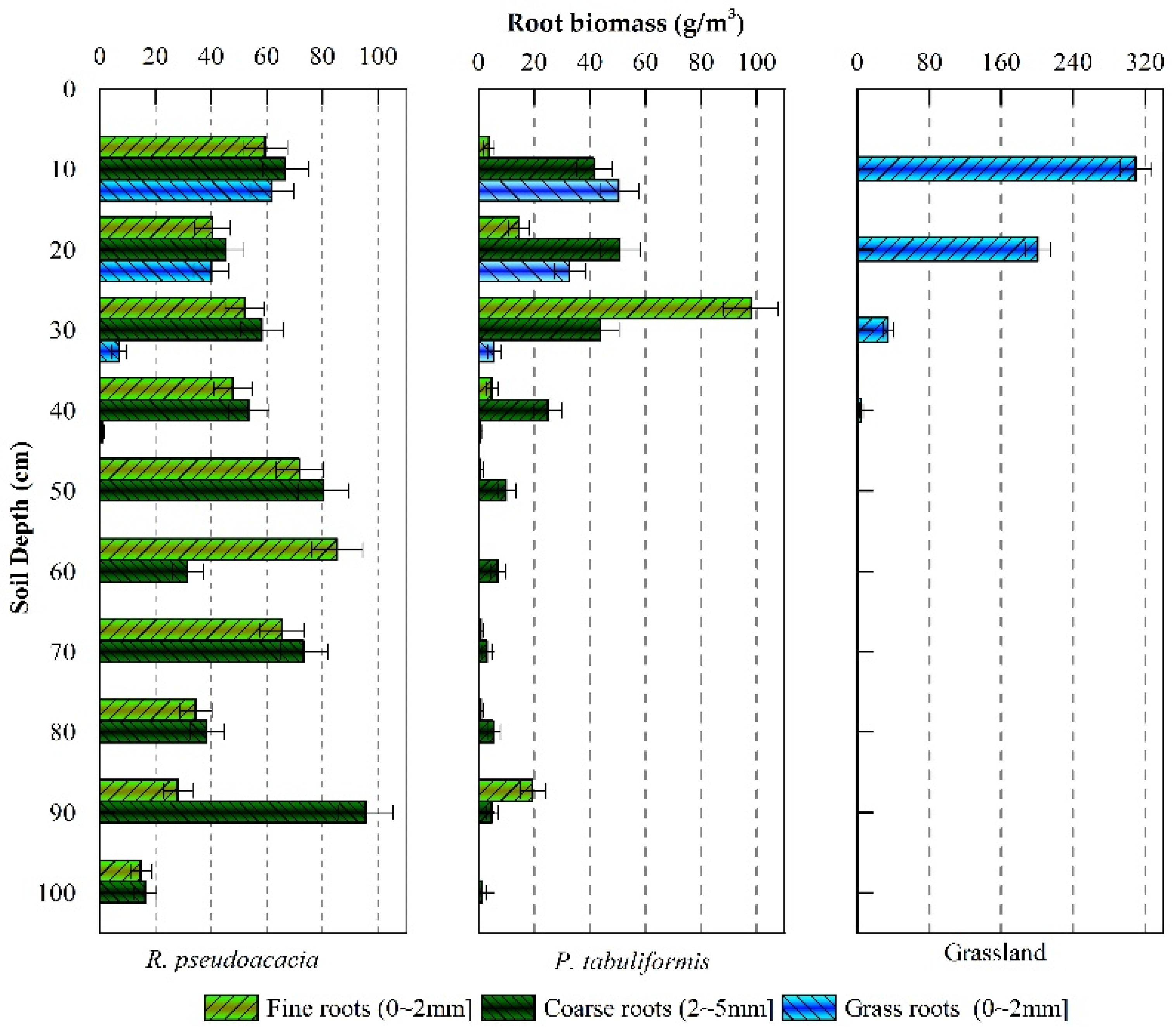
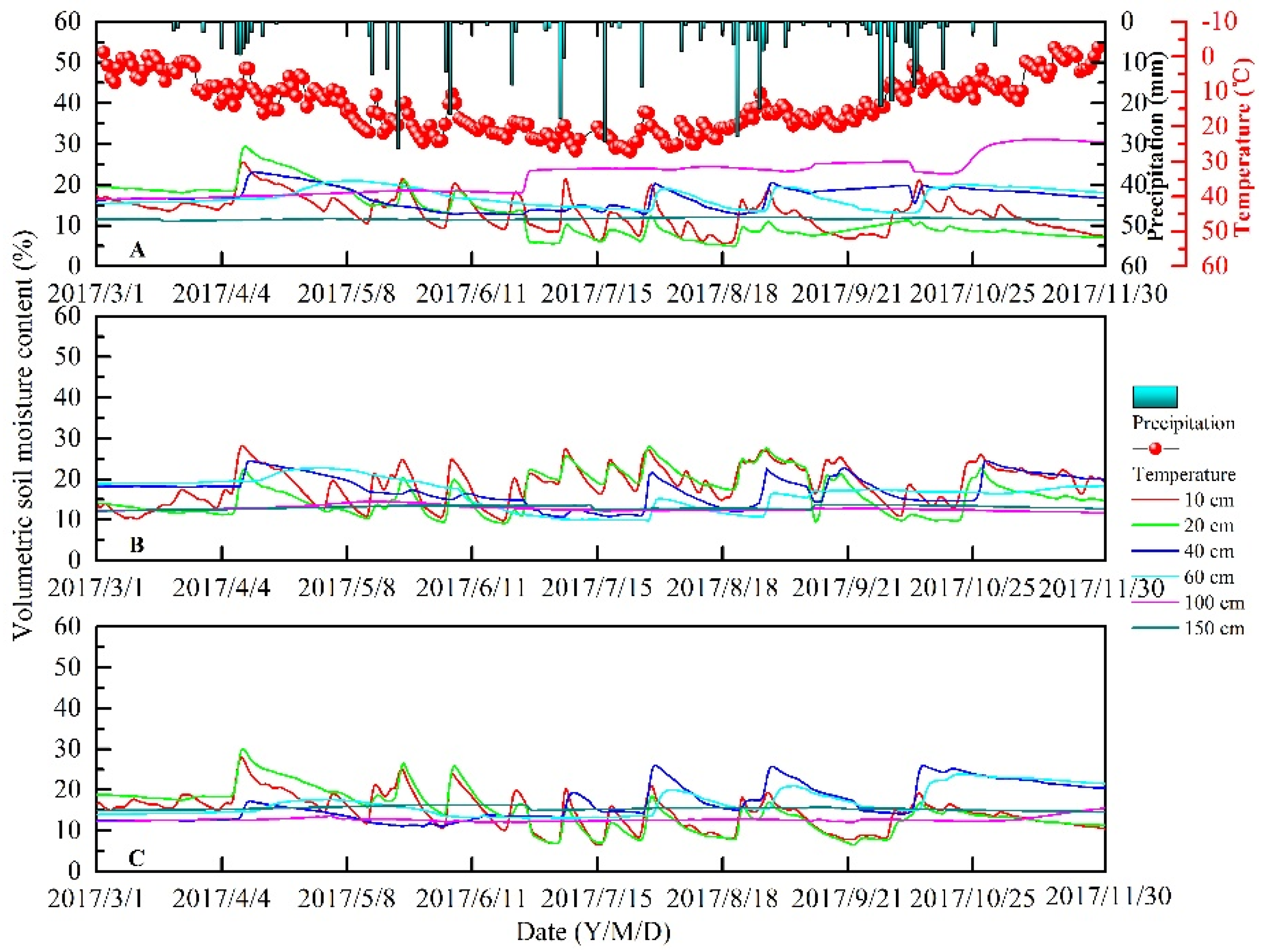
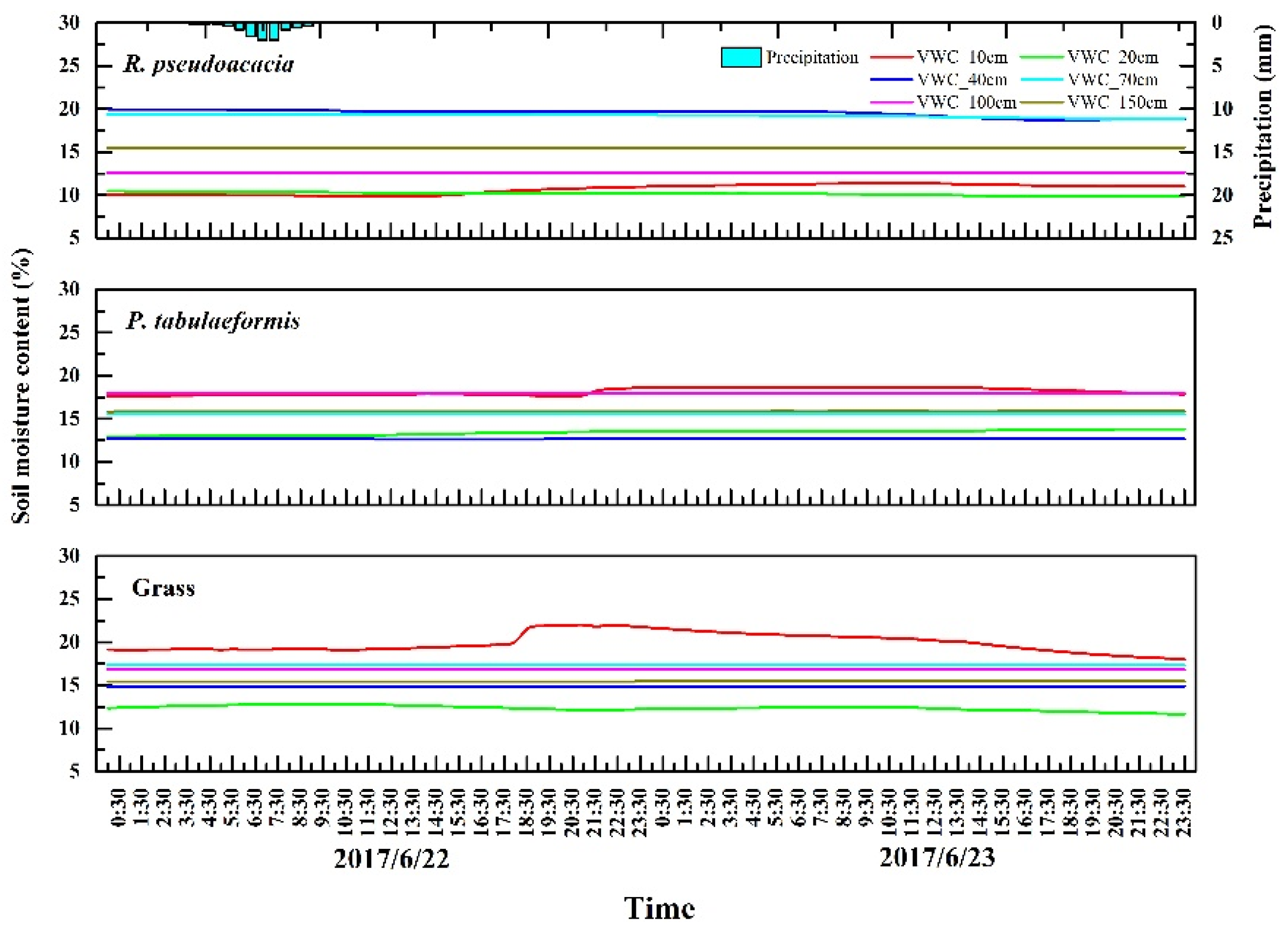

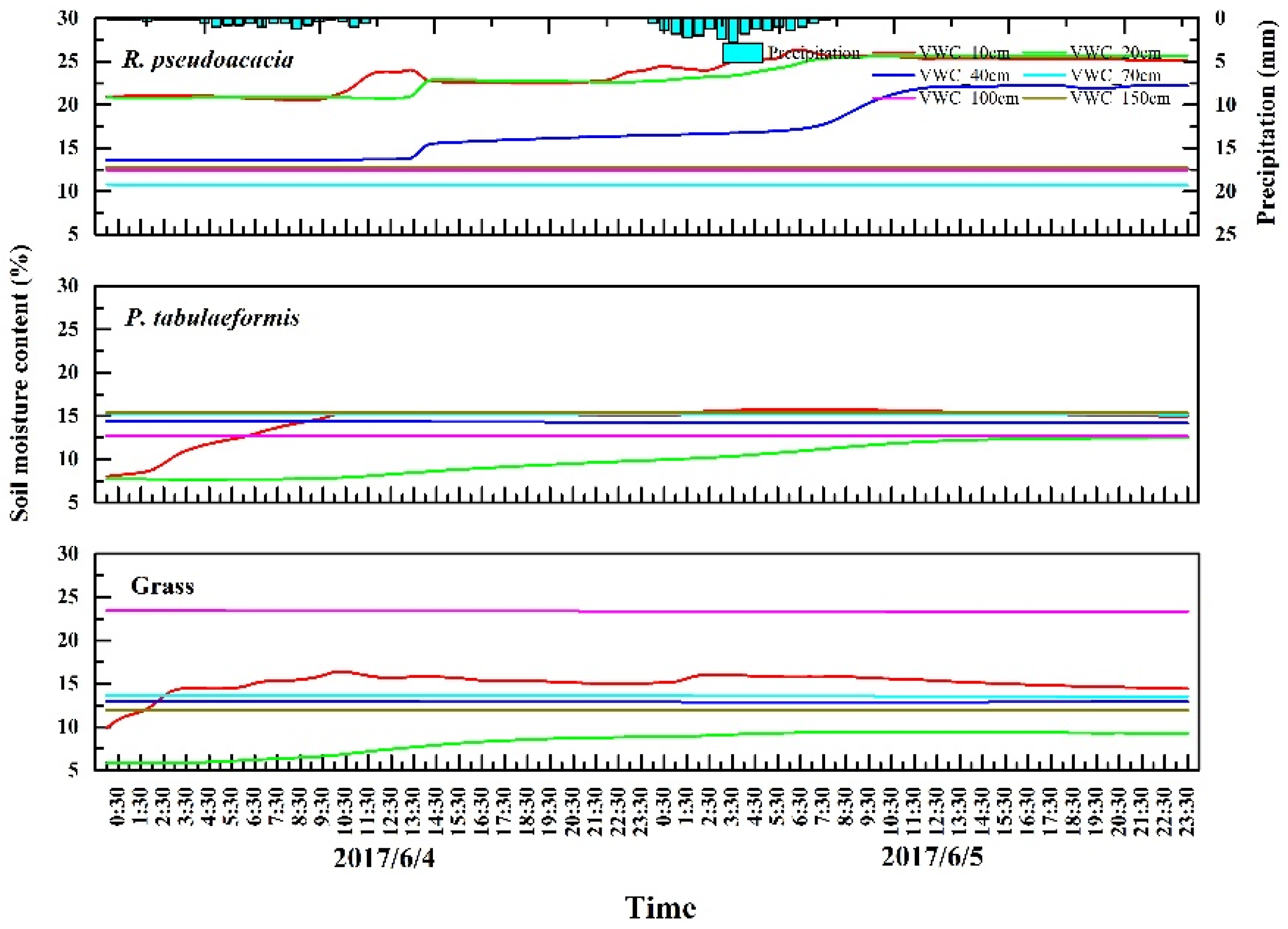
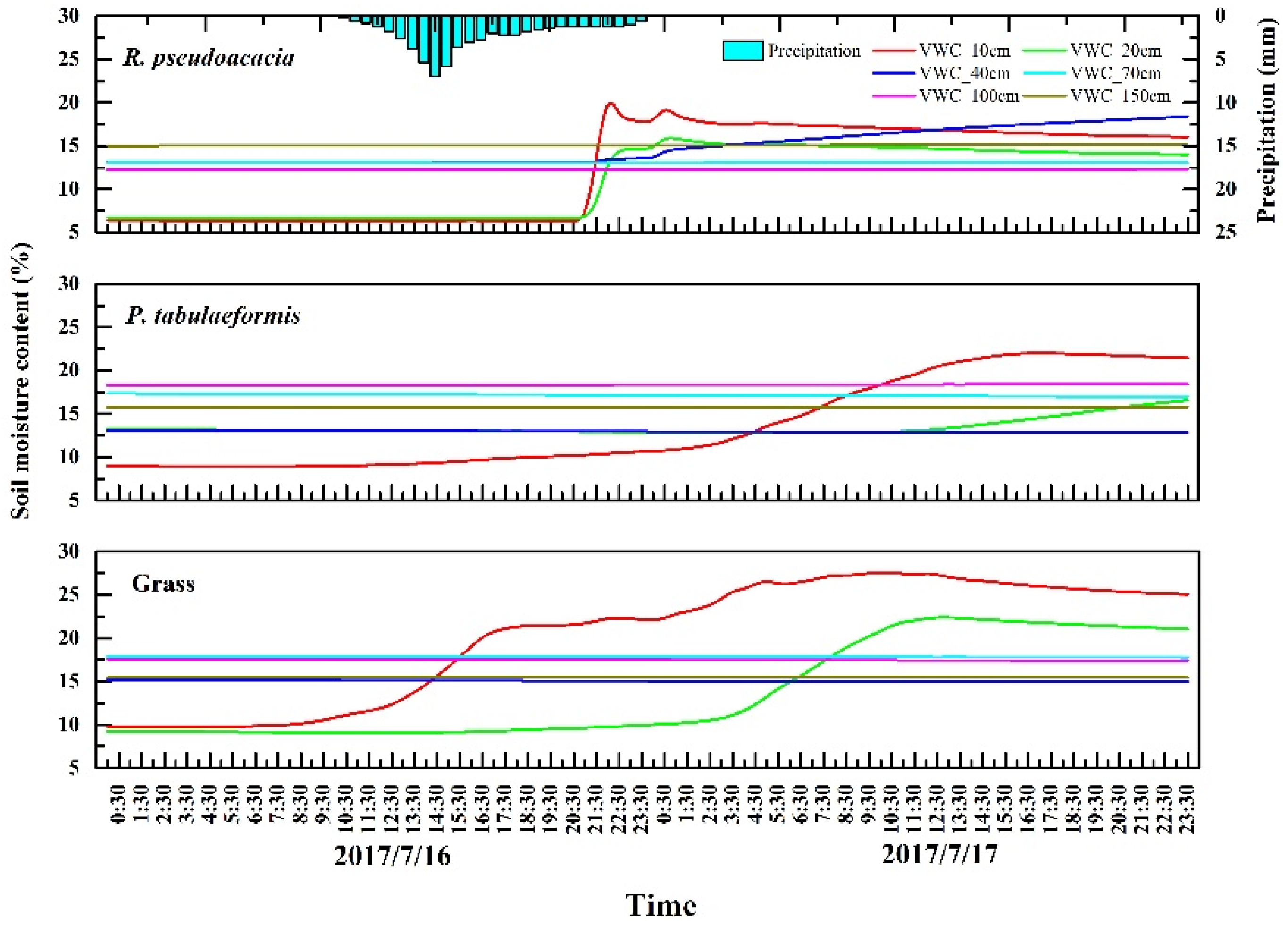
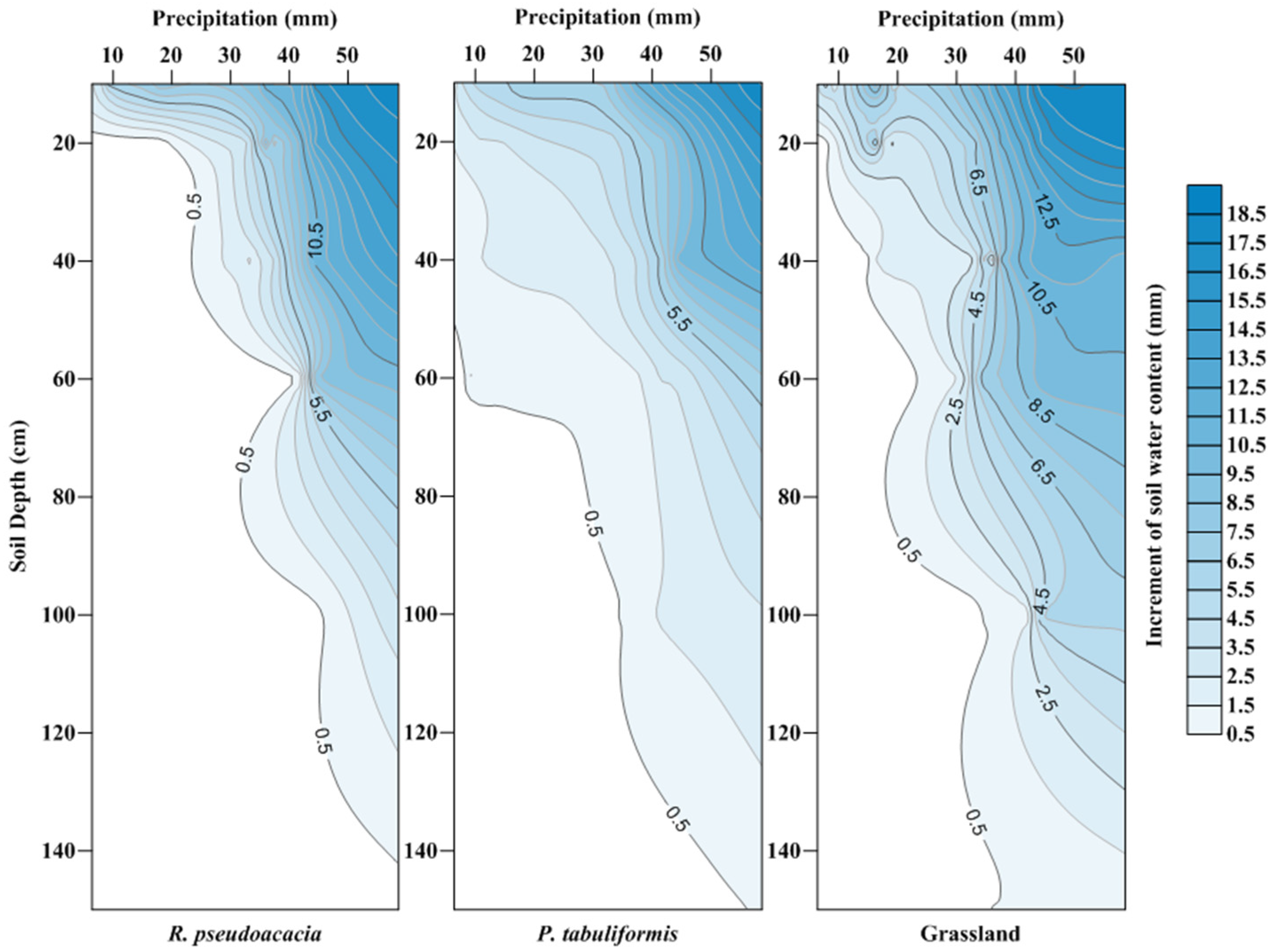
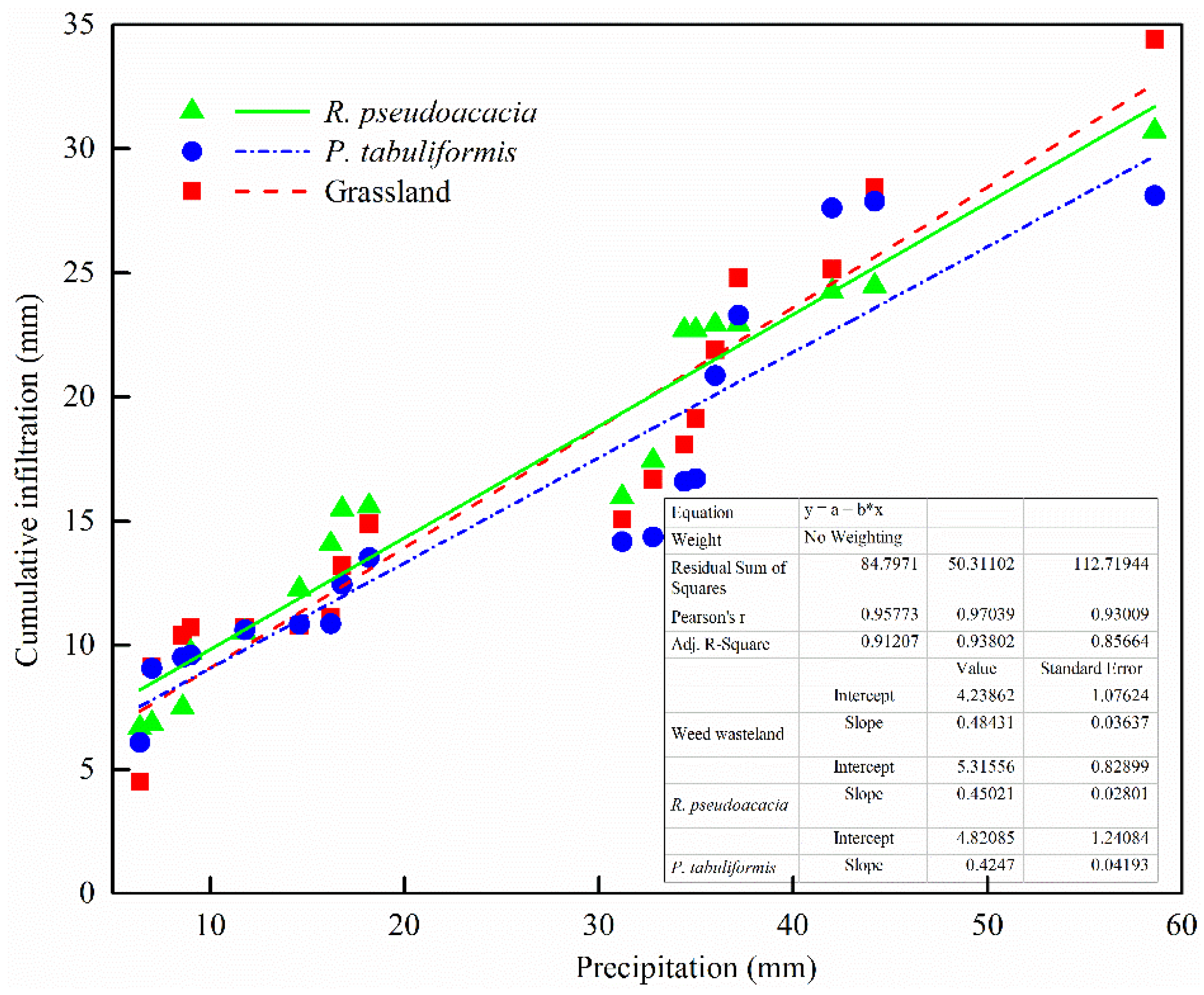
| Vegetation Types | Soil Organic Matter Content (%) | Sand (%) | Silt (%) | Clay (%) | Soil Buck Density |
|---|---|---|---|---|---|
| R. pseudoacacia | 0.91 ± 0.17a | 67.30 ± 0.62a | 21.33 ± 1.76a | 13.35 ± 1.31a | 1.07 ± 0.01a |
| P. tabulaeformis | 0.41 ± 0.03b | 67.34 ± 1.34a | 19.36 ± 0.70a | 11.33 ± 0.67a | 1.16 ± 0.13a |
| Grassland | 0.63 ± 0.15ab | 68.74 ± 0.66a | 17.96 ± 1.15a | 13.30 ± 0.67a | 0.90 ± 0.03a |
| Vegetation Types | Height | LAI | Canopy Density | Individual Biomass (kg) | Herb Coverage (%) | Aspect | Slope (°) |
|---|---|---|---|---|---|---|---|
| R. pseudoacacia | 3.5a | 2.04a | 0.76a | 8.52a | 55b | semi-sunny | 23 |
| P. tabulaeformis | 2.7b | 1.69b | 0.65 b | 2.01b | 10c | semi-sunny | 23 |
| Grassland | / | / | / | / | 90a | semi-sunny | 23 |
| Precipitation Intensity | Precipitation within 24 h |
|---|---|
| Light rainfall | [5–10] mm |
| Moderate rainfall | (10–24.9] mm |
| Heavy rainfall | (24.9–49.9] mm |
| Rainstorm | (>50] mm |
| X1 | X2 | X3 | X4 | X5 | X6 | X7 | X8 | X9 | X10 | X11 | |
|---|---|---|---|---|---|---|---|---|---|---|---|
| A | 0.929 ** | 0.857 * | 0.753 | 0.885 * | 0.889 * | 0.889 * | 0.857 * | 0.889 * | 0.889 * | 0.886 * | 0.295 |
| B | 0.919 ** | 0.912 * | 0.707 | 0.754 | 0.886 * | 0.954 ** | 0.913 * | 0.932 * | 0.522 | 0.883 * | 0.683 |
| C | 0.861 * | 0.963 ** | 0.786 | 0.891 * | 0.887 * | / | / | / | 0.957 ** | 0.948 ** | / |
© 2018 by the authors. Licensee MDPI, Basel, Switzerland. This article is an open access article distributed under the terms and conditions of the Creative Commons Attribution (CC BY) license (http://creativecommons.org/licenses/by/4.0/).
Share and Cite
Hou, G.; Bi, H.; Wei, X.; Kong, L.; Wang, N.; Zhou, Q. Response of Soil Moisture to Single-Rainfall Events under Three Vegetation Types in the Gully Region of the Loess Plateau. Sustainability 2018, 10, 3793. https://doi.org/10.3390/su10103793
Hou G, Bi H, Wei X, Kong L, Wang N, Zhou Q. Response of Soil Moisture to Single-Rainfall Events under Three Vegetation Types in the Gully Region of the Loess Plateau. Sustainability. 2018; 10(10):3793. https://doi.org/10.3390/su10103793
Chicago/Turabian StyleHou, Guirong, Huaxing Bi, Xi Wei, Lingxiao Kong, Ning Wang, and Qiaozhi Zhou. 2018. "Response of Soil Moisture to Single-Rainfall Events under Three Vegetation Types in the Gully Region of the Loess Plateau" Sustainability 10, no. 10: 3793. https://doi.org/10.3390/su10103793





